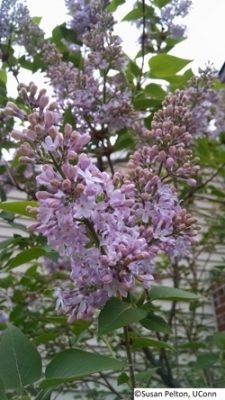The optimal time to prune spring and early summer flowering shrubs is right after they finish blooming. Pruning should be part of a regular shrub maintenance program along with fertilizing, mulching, watering and pest control.
Pruning is primarily used to control the size and shape of plants. When purchasing foundation plantings keep in mind the plant’s ultimate size. You will not be able to keep a plant that wants to be 20' tall down to a manageable 5' without negatively impacting its health and appearance. It is much better to select lower growing or dwarf varieties with an ultimate height that meets the site's needs.
Pruning is also needed to remove dead, damaged or diseased branches. A few judicious cuts can influence flowering and fruiting. Sometimes overcrowded plants require thinning and overgrown ones, renovation.
The type and extent of pruning depends on the natural growth habits of the plant and also, on the look you desire to achieve. Shrubs with upright growth habits include lilacs, many viburnums and azaleas, flowering almonds, Siberian pea shrubs, rose-of-Sharon, winterberry, dogwoods with colored stems and enkianthus. Those with more weeping or vase-like forms of growth consist of species like forsythia, mock orange, beauty bush, weigela, some varieties of spirea, kerria and ninebark.
A common mistake made when pruning spring flowering shrubs is to just cut back the top growth on multi-stemmed shrubs like a spirea, forsythia or ninebark. Although the pruning will remove some growth, it also encourages new buds and shoots to grow, much like pinching a basil plant. So, cutting back the top growth will stimulate more top and side growth resulting in a top-heavy plant. Sometimes the plant is growing out of bounds and some top pruning is necessary but the key to keeping multi-stemmed shrubs a decent size is to remove one or more of the oldest stems at the base each year which will stimulate new shoots to arise from the base.
Most multi-stemmed flowering shrubs bloom more prolifically on younger 2 to 3-year-old wood. Flowering is reduced as the stem ages. A shrub that has several of each of 1, 2 and 3-year-old stems is ideal. Each year a couple of the older stems would be removed stimulating new ones to grow to replace them. Sometimes a bit of extra thinning is also needed when the shrub becomes too crowded and air cannot circulate well within the interior of the plant.
 This system of whole stem renewal is the key to successful renovation of suckering plants such as lilacs. Severely overgrown plants may take 3 years of pruning to bring them back into form. Up to one-third of the older stems can be cut to the ground each year allowing for new replacements.
This system of whole stem renewal is the key to successful renovation of suckering plants such as lilacs. Severely overgrown plants may take 3 years of pruning to bring them back into form. Up to one-third of the older stems can be cut to the ground each year allowing for new replacements.
Shrubs that respond well to having some of the 3 to 4-year-old stems removed include forsythia, weigela, deutzia, mock orange and beauty bush. Colors on yellow, red and coral stemmed dogwoods and on the apple green stemmed kerrias are more vibrant on the new growth as well. Remove older branches as they lose their color.
Once you have thinned out the older wood, you can head back the remaining branches, if necessary. Do this by cutting back to a side stem or bud. Cuts should be made at a slight angle about a quarter inch above the stem or bud. This method of heading back is generally used on slower growing, often single-stemmed shrubs, like fragrant viburnums and rhododendrons. As a general rule of thumb, slow growing rhododendrons, azaleas, mountain laurels and the like are only pruned to remove the occasional wayward branch as well as areas of the plant killed over the winter or damaged by deer browsing.
Occasionally, plants like privet or spirea are in dire straits and need to be cut back to the ground. This needs to be done in March.
Pruning tools should be sharp and in good shape. Be sure to choose the right tool for the job. Hand pruners can be used on branches less than ¾" in diameter but loppers or a pruning saw are needed for larger cuts. For stems over 2", a hand saw or a chain saw would be useful depending on how many cuts need to be made.
Please visit our fact sheet on Pruning Terminology for additional information.
Despite good cultural practices, pests and diseases at times may appear. Chemical control should be used only after all other methods have failed.
For pesticide information or other questions please call toll free: 877-486-6271.
UConn Home and Garden Education Center, 2018